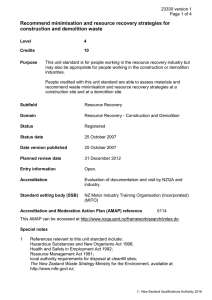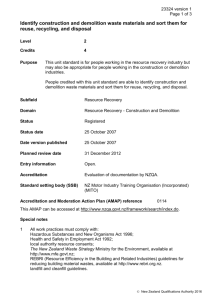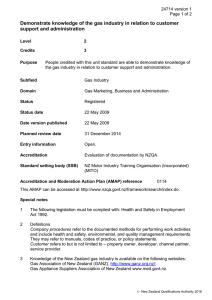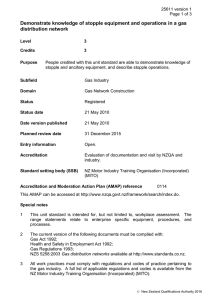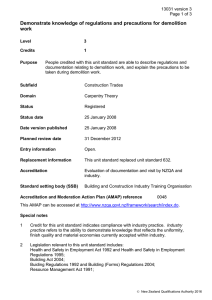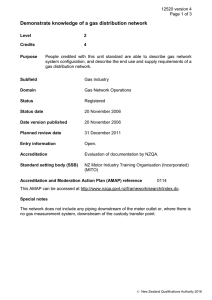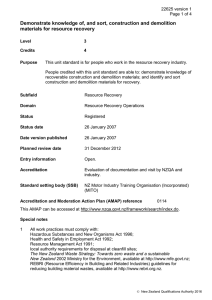Demonstrate knowledge of the recovery of resources from construction
advertisement
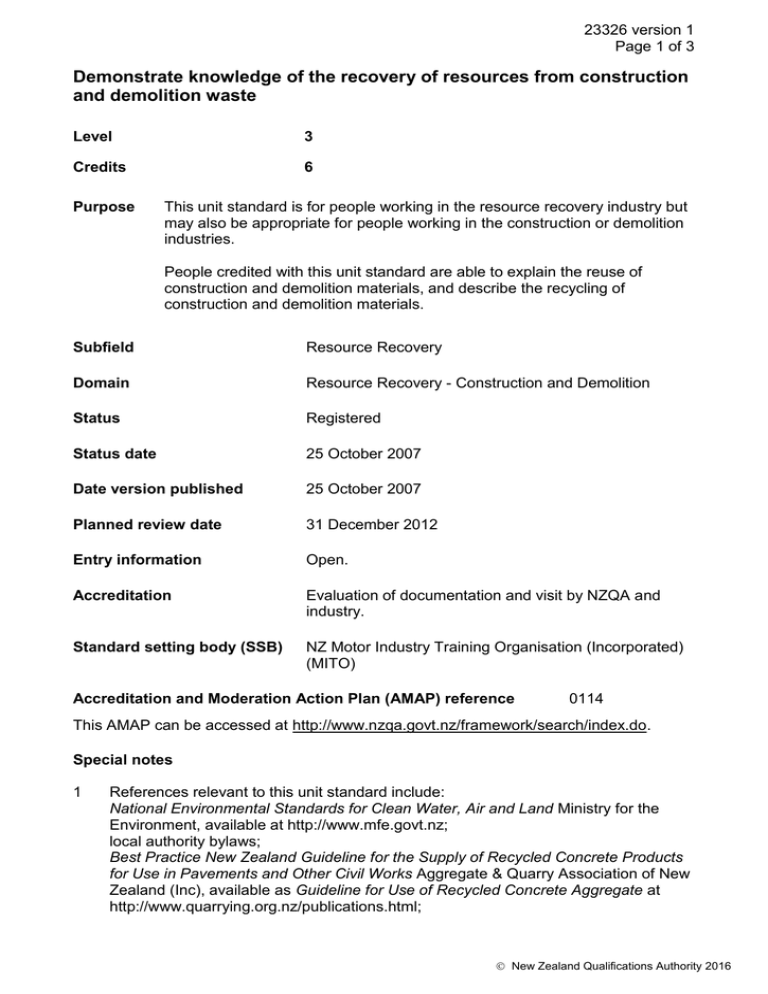
23326 version 1 Page 1 of 3 Demonstrate knowledge of the recovery of resources from construction and demolition waste Level 3 Credits 6 Purpose This unit standard is for people working in the resource recovery industry but may also be appropriate for people working in the construction or demolition industries. People credited with this unit standard are able to explain the reuse of construction and demolition materials, and describe the recycling of construction and demolition materials. Subfield Resource Recovery Domain Resource Recovery - Construction and Demolition Status Registered Status date 25 October 2007 Date version published 25 October 2007 Planned review date 31 December 2012 Entry information Open. Accreditation Evaluation of documentation and visit by NZQA and industry. Standard setting body (SSB) NZ Motor Industry Training Organisation (Incorporated) (MITO) Accreditation and Moderation Action Plan (AMAP) reference 0114 This AMAP can be accessed at http://www.nzqa.govt.nz/framework/search/index.do. Special notes 1 References relevant to this unit standard include: National Environmental Standards for Clean Water, Air and Land Ministry for the Environment, available at http://www.mfe.govt.nz; local authority bylaws; Best Practice New Zealand Guideline for the Supply of Recycled Concrete Products for Use in Pavements and Other Civil Works Aggregate & Quarry Association of New Zealand (Inc), available as Guideline for Use of Recycled Concrete Aggregate at http://www.quarrying.org.nz/publications.html; New Zealand Qualifications Authority 2016 23326 version 1 Page 2 of 3 REBRI (Resource Efficiency in the Building and Related Industries) guidelines for reducing building material wastes, available at http://www.rebri.org.nz; customer specifications for bio fuel and recovered timber. 2 Definitions Recycle means any process by which waste and recyclable materials are transformed or collected for the purpose of being transferred into new products. Reuse means repeated use of a product in the same form but not necessarily for the same purpose. Elements and performance criteria Element 1 Explain the reuse of construction and demolition materials. Performance criteria 1.1 Explanation provides examples of reuse of materials for practical use. Range 1.2 Explanation describes restrictions on reuse of materials for similar purpose. Range 1.3 one each of – structural, lining, fittings, landscaping, creative. restrictions – defects in material, change of building code, structural material requiring engineering report on condition; materials– lead based paint, tanalised timber, one other. Explanation provides examples of reuse of materials for different purpose. Range at least three examples from – masonry, timber, roofing, door, carpet, other. Element 2 Describe the recycling of construction and demolition materials. Performance criteria 2.1 Description identifies commercially available products that have been reprocessed from construction and demolition waste and explains the process. Range 2.2 products – concrete, metal, wood, plasterboard, glass, plastic. Description identifies and explains requirements for ensuring that materials are acceptable for recycling. Range quantities, contamination levels, defects, markets; evidence is required of at least three materials. New Zealand Qualifications Authority 2016 23326 version 1 Page 3 of 3 Please note Providers must be accredited by NZQA, or an inter-institutional body with delegated authority for quality assurance, before they can report credits from assessment against unit standards or deliver courses of study leading to that assessment. Industry Training Organisations must be accredited by NZQA before they can register credits from assessment against unit standards. Accredited providers and Industry Training Organisations assessing against unit standards must engage with the moderation system that applies to those standards. Accreditation requirements and an outline of the moderation system that applies to this standard are outlined in the Accreditation and Moderation Action Plan (AMAP). The AMAP also includes useful information about special requirements for organisations wishing to develop education and training programmes, such as minimum qualifications for tutors and assessors, and special resource requirements. Comments on this unit standard Please contact the NZ Motor Industry Training Organisation (MITO) info@mito.org.nz if you wish to suggest changes to the content of this unit standard. New Zealand Qualifications Authority 2016
